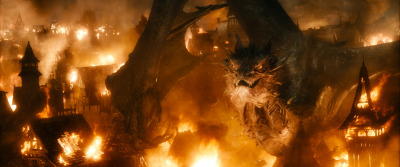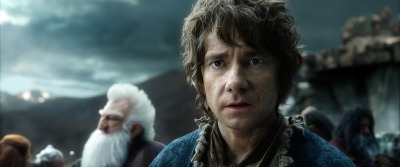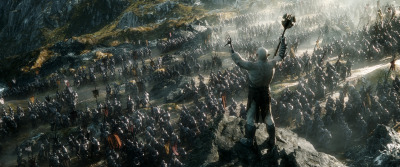After a tonally confused beginning and terrific middle episode filled with all kinds of invention, The Hobbit: The Battle of the Five Armies brings Peter Jackson’s six-movie Tolkien binge to close with a rousing mid-point finale that both wraps up the story and sets the stage for the Lord of the Rings trilogy quite nicely.
With The Hobbit: An Unexpected Journey, it seemed that Jackson and his co-writers couldn’t quite decide whether the movie should be a wistful tale with a slightly melancholy edge like the children’s book from whence it sprang, or a thundering great epic like his Lord of the Ring trilogy. The result was an entertaining movie that overcame its Dissociative Identity Disorder through the charm of the cast and the otherwise intelligent use of Tolkien’s book, notes, LOTR appendices and outright invention.
By the time The Hobbit: The Desolation of Smaug’s end credits rolled, the tone was firmly set in the LOTR mode – though with substantially more humor – and the journey was more about the horde of characters. The result was a rousing set up for a Jacksonian big finish – with a nifty cliffhanger to add impetus to the audience’s desire to see the final film.
The Hobbit: The Battle of the Five Armies is the big Jacksonian finish.
TBotFA opens with Smaug’s destruction of Laketown. We follow various characters: Bard the Bowman (Luke Evans), the Mayor (Stephen Fry), Alfrid (Ryan Gage) and the injured Kili (Aidan Turner) and Bard’s children – aided by Tauriel (Evangeline Lilly) and Legolas (Orlando Bloom), as they flee the burning town.
We then cut to Erebor where Thorin Oakenshield (Richard Armitage) is behaving very out of character as the gold fever has him in its thrall – much to the despair of the rest of his company, especially Bilbo (Martin Freeman).
Laketown’s survivors journey to the mountain for the share of treasure that Thorin promised them so that they can rebuild their lives in the town at the base of the mountain. They arrive to find an army of elves, led by Thranduil (Lee Pace), arriving. Thranduil has come to take home a particular necklace of white gems. Thorin refuses them both.
Meanwhile, the orc armies are also coming. Things look dire – and we haven’t even gotten to the dwarf army and that fifth army mentioned in the title. Or Gandalf (Ian McKellen), for that matter.
Although a majority of the movie’s 144-minute running time (the shortest of Jackson’s six Tolkien films) is devoted to action, there are plenty of good, solid character moments – not all of them happy. Before the battle is over main characters will die, hearts will be broken and emotional generosity will be given by unexpected characters.
If you’re looking for action, you’ll get more than you need. If you’re looking for romance, you’ll get a bit of that (in both sense of the word). There’s grand villainy and equally grand heroism to be found and enjoyed in The Battle of the Five Armies – and there’s not a moment that rings false.
The effects – both CG and practical – are more impressive than ever, too. The folks at WETA have continued to create and innovate and the film’s titanic battle sequences feel as real as is humanly possible to make them. The mo-cap characters – like orc baddies Azog and Bolg – are very, very convincing.
There’s even a sequence in which ancient wizard Saruman the White (Christopher Lee) kicks much ass which great glee.
Of course, all the technical stuff doesn’t matter if the film is shot and edited poorly, so it’s only fair to mention that cinematographer Andrew Lesnie does some pretty brilliant work here – as does Film Editor Jabez Olssen.
The Hobbit: The Battle of the Five Armies is, simply put, a brilliant bit of epic fantasy.
Final Grade: A
Photos courtesy of Warner Bros. Pictures


